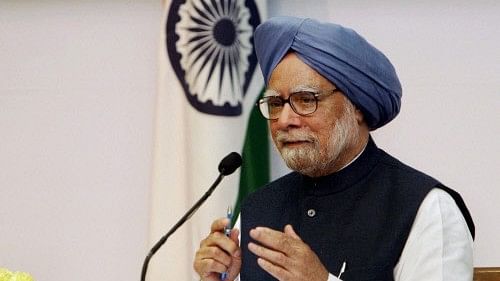
Manmohan Singh's Budget in 1991 is a landmark in Indian financial history.
Credit: PTI File Photo
Finance Minister Nirmala Sitharaman will be presenting the Union Budget for the Financial Year 2024-25 on February 1.
Since the country is going for Lok Sabha elections soon, Sitharaman will be presenting only an interim budget.
As the country braces for the interim budget, here is a look at five budgets that shaped the Indian economy.
T T Krishnamachari, 1957-58
T T Krishnamachari introduced path-breaking tax reforms in his Budget for the Financial Year 1957-58, with the highlight being the wealth tax which would be levied on the total value of personal assets. The wealth tax continued in various avatars before being abolished in 2015.
Manmohan Singh, 1991-92
When P V Narasimha Rao pulled finance expert Manmohan Singh out of obscurity and made him the Finance Minister, nobody knew what was coming.
In what could be described as the landmark Budget in Indian history, the former RBI Governor ushered in a series of reforms which saved the country from a severe financial crisis.
Manmohan, who was more of an economist (he had served as Chairman of the Planning Commission as well as Chief Economic Advisor to the Government), used all his experience as he revamped the import-export policy and took measures to make the Indian economy more global trade-friendly. The customs duty was slashed from 220 per cent to 150 per cent and steps were taken to promote exports. Manmohan’s landmark Budget enhanced India’s reputation globally and it also signalled the end of the ‘Licence Raj’ and beginning of economic liberalisation.
P Chidambaram, 1997-98
P Chidambaram, who was Manmohan Singh’s understudy in the Narasimha Rao cabinet, came out of his master’s shadows as he himself delivered a stellar Budget when he became the Finance Minister in the United Front government.
Just like Manmohan, Chidambaram used his vast economic and financial background while presenting the Budget. A highlight of the Budget, which was called ‘Dream Budget’ by financial experts, was that he brought down personal income tax and corporate tax. Chidambaram brought down the highest personal income tax rate from 40 per cent to 30 per cent and did away with many surcharges and slashed royalty rates. The lower tax rates was a huge relief for the common man and industry experts rated it as one of the best Budgets presented in the country.
Yashwant Sinha, 2000-01
The finance ministry has always been held by stalwarts and Yashwant Sinha was no exception. What Sinha could not achieve under the Chandra Sekhar ministry (where he could not present a full Budget as the government fell quickly), he delivered under Atal Bihari Vajpayee’s regime. Sinha’s Budget revolutionised the country’s Information Technology (IT) sector. His proposal to lower customs duty on 21 items, including computers for the IT sector, led to a boom in the industry.
Arun Jaitley, 2017-18
This Budget had many firsts to its credit—the first and foremost being that the country ended the age-old practice of presenting Union Budget and Railway Budget separately. For the first time in Independent India, the tradition of railway minister presenting the railway budget and the finance minister presenting the Union Budget was done away with and instead Jaitley, the then Finance Minister, presented a common budget and it has been the norm since then.